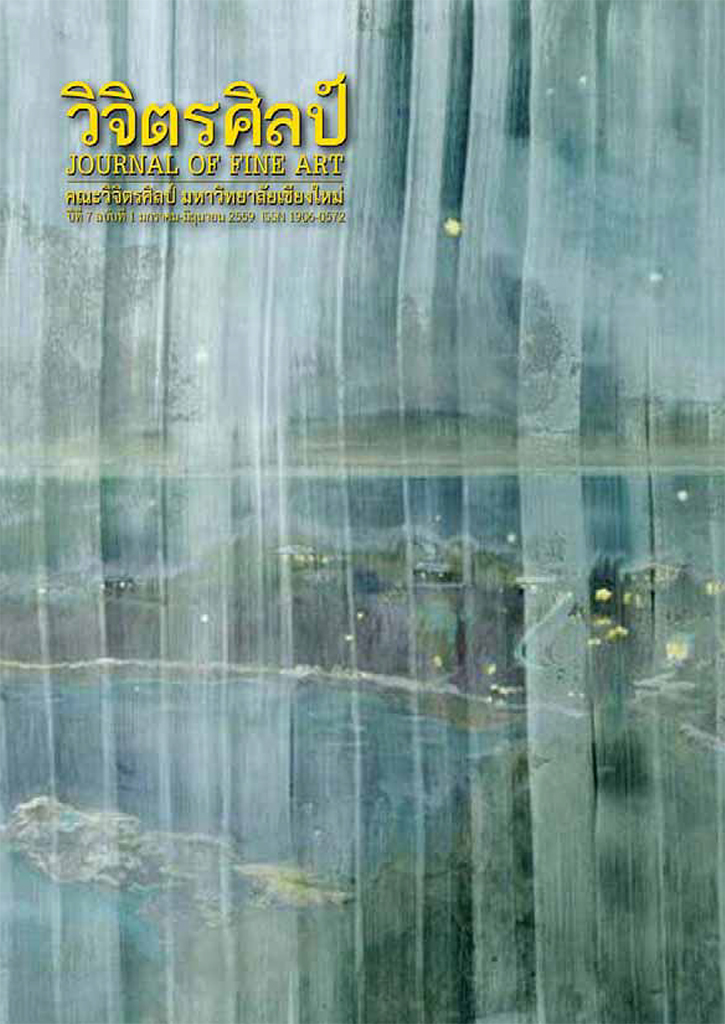วัฒนธรรมการบรรเลงดนตรีไทใหญ่จังหวัดเชียงใหม่
Main Article Content
Abstract
งานวิจัยเรื่องวัฒนธรรมการบรรเลงดนตรีไทใหญ่ จังหวัดชียงใหม่มีวัตถุประสงค์เพื่อศึกษาการบรรเลงดนตรีไทใหญ่ที่ปรากฏในจังหวัดเชียงใหม่และรวบรวมทำนองเพลง ผลการวิจัยพบการอ่านธรรมการเฮ็ดความ การตีกลองก้นยาว การตีกลองมองเซิง การเป่าปี่นํ้าเต้า การดีดติ่งตุม การตีสีคาบและการบรรเลงวงดนตรีที่เรียกว่าดนตรีจ้าดไต และยังพบว่าจังหวัดเชียงใหม่ มีการบรรเลงดนตรีไทใหญ่ที่มีความเข้มแข็งมากที่สุดจังหวัดหนึ่งในประเทศไทยด้วย
การศึกษาการบรรเลงดนตรีไทใหญ่พบว่าการตีกลองก้นยาวมีการใช้เครื่องกำกับจังหวะขึ้นต้นทุกครั้ง สำนวนช่วงลงจบการตีกลองก้นยาวไม่ว่าจะตีด้วยวัตถุประสงค์ใดจะลงจบด้วยเสียงปิดหรือการหยุดเสียงด้วยการตีกดลงบนหน้ากลองทั้งสิ้น และกระสวนทำนองกลองเมื่อนำไปใช้ต่างโอกาสสามารถนำมาตีทดแทนกันไปมาได้ การตีกลองมองเซิง มีลักษณะที่โดดเด่นคือขึ้นต้นด้วยเสียงฉาบเป็นอันดับแรกเพื่อลักษณะเสียงที่อ่อนหวาน เสียงกลองมองเซิงได้แก่ “เสียงตึง” จะตีพร้อมกับเสียงมอง และลักษณะกระสวนทำนองกลองมองเซิงปรากฏ 6 กระสวนหลัก การเป่าปี่น้ำเต่าพบลักษณะการการเป่าทำนองยาวๆ โดยไม่มีจังหวะเข้ามาควบคุม ทำนองส่วนใหญ่ใช้เสียงทางเสียงสูงและมีการรวบเสียงการดีดติ่งตุม เป็นการดีดไม้ไผ่ด้วยมือขวาและมือซ้ายประกอบกันเพื่อเลียนแบบให้เกิดเป็นทำนองอย่างกลองก้นยาวและกลองมองเซิง โดยมือขวาจะดีดยืนเป็นเสียงมอง มือซ้ายดำเนินทำนองกลอง การตีสีคาบเป็นลักษณะการกำกับจังหวะหนัก เช่นเดียวกับการตีกรับในวงดนตรีไทย เพื่อให้การบรรเลงรวมวงเกิดความหนักแน่น และเพื่อเป็นจังหวะให้กับนักดนตรีทุกคนสามารถบรรเลงได้พร้อมเพรียงกัน
การศึกษาและรวบรวมทำนองเพลงที่ปรากฏพบว่า การอ่านธรรม ถือได้ว่าเป็นภูมิปัญญาไทใหญ่ โดยผู้สูงอายุที่ได้รับการยอมรับในสังคม ใช้เป็นสื่อในการสอนคนในสังคมและเยาวชนให้เป็นคนดี การอ่านธรรมมีการใช้เสียงน้อยที่สุด 3 เสียงและใช้เสียงมากที่สุดไม่เกิน 5 เสียง ทำนองส่วนใหญ่เมื่อขึ้นต้นด้วยเสียงใดจะจบทำนองสุดท้ายด้วยเสียงเดิม การดำเนินทำนองยังพบการลากเสียงไหลเป็นคู่ 2 คู่ 3 คู่ 5 และพบว่าการลากเสียงลูกตกของทำนองเพลงห้องที่ 3 การเฮ็ดความ แบ่งทำนองออกเป็น 4 วรรค แต่ละวรรคมีแนวการบรรเลงแตกต่างกัน วรรคแรกจังหวะช้า วรรคที่ 2 จังหวะ “ช้า-เร็ว-ช้า” วรรคที่ 3 จังหวะเร็วขึ้น 1 เท่าตัวจากวรรคที่ 1 วรรคสุดท้ายเป็นทำนองลงจบมีลีลาคล้ายการพูดและจบท้ายด้วยการลากเสียงร้องยาว ส่วนเสียงของลูกตกวรรคที่ 1 วรรคที่ 2 และวรรคที่ 4 เป็นเสียงเดียวกันคือเสียงซอล ส่วนวรรคที่ 3 มีลูกตกเสียงที่ทำนองดนตรีจ้าดไต เป็นทำนองเพลงที่เน้นเนื้อร้องเพื่อดำเนินเรื่องราวเป็นสำคัญดนตรีทำหน้าที่บรรเลงคลอไปกับเสียงร้องและบรรเลงรับทำนองเดียวกับการขับร้องโดยไม่เน้นการเปลี่ยนแปลงทำนองเป็นอย่างอื่น การบรรเลงมีทำนองขึ้นต้นหรือท่อนนำก่อนเข้าสู่บทร้อง พบการใช้เสียงครบทั้ง 7 เสียงเรียงร้อยเป็นทำนอง ทำนองร้องจะร้องเป็นเสียงตรงไปตามคำร้องที่กำหนดในบทเพลงนั้น ไม่มีการร้องเอื้อนประกอบ หากไม่มีคำร้องจะมีการกำหนดเสียงลูกตกที่สม่ำเสมอกันทุกวรรคเพลง และพบลักษณะการใช้เสียงเรียงกันปรากฏทั้งเรียง 3 เสียงและเรียง 4 เสียงเป็นส่วนใหญ่
Tai Yai’s Musical Performing Culture in Chiang Mai Province
The objectives of this research on the musical culture of the Tai Yai ethnic group in Chiang Mai Province are to study the existing musical performance tradition of the Thai Yai in Chiang Mai province and to compile its melodies. The research found Tai Yai musical performance to consist of Arn Tham, Hed Khwam and the performance of Klong Kon Yao drum, Klong Mong Serng drum, Pi Nam Tao flute, Ting Tum and Sikarb rhythmic instruments as well as the performance of Jat Tai musical ensemble. It also found Chiang Mai to be one of the provinces with the most active Thai Yai musical tradition in Thailand. The study of Tai Yai music reveals that Klong Kon Yao ensemble performance: This type of drum is used to lead and control each of the beginning rhythm. The ending rhythm of Klong Kon Yao drum performance, which is performed for whatever purpose, normally ends in an abrupt pressing of hand on the drum head. Klong Kon Yao tunes designated for different occasions can be played alternately as deemed fit. Mong Serng drum performance: The distinctive characteristic of this drum performance is its grand opening with the sweet sound of cymbals. The unique sounds of Mong Serng drum are the “Tueng” sound which is played simultaneously with the Mong sound. The performance has 6 apparent rhythmic patterns. Pi Nam Tao flute performance: This type of flute is usually played in lengthy melody in free rhythm. High and shortened pitches are used in the majority of its melodies. Ting Tum performance: This is a flicking of bamboo tubes with both hands to imitate the melodies of Klong Kon Yao and Klong Mong Serng drums. The main Mong melody is played by the right hand while the drum melodies are played by the left hand. Si Karb performance: This is a rhythmic control instrument, similar to the Krub clapper of the Thai musical ensemble, played to keep all musicians performed in unison. The findings of Tai Yai melodies show that Arn Tham is a form of Tai Yai’s local wisdom by the elderly with social recognition through their reading of Dharma to cultivate good characters among both adults and children of a community. A minimum of 3 pitches and a maximum of 5 pitches are used in Arn Tham. The reading begins and ends with the same pitch. The flow of the reading employs a 2nd, 3rd and 5th interval and extension of the third pivotal pitch of each phrase. In Hed Khwam, the melody is divided into 4 lines with different tune for each one. The first line is played in a slow tempo; the second in a “slow-quick-slow” tempo and the third is played in the double tempo of the first line. Pharses are normally ended with ends with a long-drawn drawl. Sol is used as the pivotal pitch in the first, second, and fourth phrases. Jat Tai musical performance: The melodies of this musical ensemble focus mainly on the song lyrics of the performance. Its primary role is to provide soft melodies for the accompaniment and support of the singing. It provides an overture to introduce the singing lyrics. Jat Tai melodies use all seven pitches. The singing melody keeps up with the lyrics of each song and no long-drawn voicing is used in this type of singing. At the section of the performance when there is no lyric the drop voicing will fall at regular rhythms for all paragraphs. The majority of Jat Tai melodies consist of consecutive pitches of three or four melodic units.


